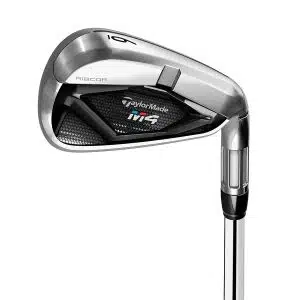Manufacturers of golf clubs are constantly improving on the technology and trying to outdo one another. In the upper end of the market, Callaway Rogue irons vs TaylorMade M4 irons are good clubs that compete well and are close in performance.
In this piece, we will look at the features of the two brands and provide you with the facts available.
Callaway Rogue Irons
The Callaway Rogue family consists of 3 sets for men and one set for ladies. The clubs aimed at men are the Callaway Rogue Standard, Callaway Rogue X, and the Callaway Rogue Pro. The Callaway Rogue W is aimed specifically at the ladies’ market. In this piece, we will concentrate on the Callaway Rogue Standard model.
Target Market
Callaway Rogue X benchmark for super game improvement irons was released in 2018. Most agree that they provide extra distance, are very forgiving, and amazingly easy to hit. The Rogue X looks somewhat bulky and can be distracting for some players.
The Rogue (standard) is in the middle of the family with a more refined look than Rogue X. This is aimed at players that can strike the ball reasonably well and require a high ball flight and lots of forgiveness.
The Rogue Pro irons are aimed at golfers that require a bit more from their irons. They are more workable but still provide ample forgiveness.
Features
The clubs offer distinctive features to provide the best possible solution to golfers. The features resulted from years of R&D and ultimately provide similar performance.
- The face of the Callaway Rogue is built with the 360 Face Cup technology and Variable Face Thickness (VFT) to improve the ball speed off the face
- MIM’d Internal Standing Wave for Optimal Flight and Control
- Inside the clubface, Callaway used Urethane Microspheres behind the face to dampen the impact between the golf ball and clubface for an enhanced feel
Dimensions
- 2 inches X 4.8 inches X 3.5 foot
Set Make-Up
- All sets are available in the left-hand and right-hand configurations. The 59° LW is only available for right-handed golfers
- Swing weights for graphite shafts are D1 and steel shaft is D3
- The offset decreases from 0.270 on the 3 iron to 0.125 on the LW
- The lie increases from 59.75° on the 3-iron to 63.50° on the 9-iron. All wedges have a lie of 64.00°
- The Rogue standard set comes with all clubs from a 3-iron to an LW
- The Rogue Pro set comes with all clubs from a 3-iron to an LW
- The Rogue X set comes with all clubs from a 4-iron to an SW
Shafts
Rogue
- Aldila Quaranta (LL and W flex) (Graphite)
- Aldila Synergy (L, R and S flex) (Graphite)
- True Temper XP (R and S flex) (Steel)
Rogue Pro
- XP 105 Stepless (R, S and XS flex) (Steel)
Rogue X
- Aldila Synergy (L, R and S flex) (Graphite)
- KBS Max 90 (R and S flex) (Steel)
Look, Sound and Feel
Long-distance, good feel, and a good sound off the clubface have not been a combination that too many manufacturers have achieved. In our opinion, the Callaway Rogue and TaylorMade M4 still have to do some work to get the combination working.
- Callaway Rogue Standard
The VFT and 360 Face Cup Technology has improved the ball speed and the distance that you can achieve with the Callaway Rogue.
The use of elastic-urethane microspheres has helped to dampen vibration, improve the sound, and feel, but it had an insignificant impact on the flexibility of the clubface or lowering COR and ball speed. The small glass spheres that have been included in the urethane in the cavity create little air pockets that absorb the unwanted sounds.
The sound remains a little “clicky” as with most game improvement irons with air in the cavity back.
The microspheres enhanced the feel off the face, but it still does not provide the feel of a forged club.
Looking at the club at address, the head is rather large with medium topline with a progressive offset as you go down the numbers. The sole-width is medium and not too distracting.
The corporate Rogue color may not be to the liking of all golfers.
CoG, CoR, and MoI
On the inside the Rogue irons, you will find Callaway’s fastest 360 Face Cup to date and the weight has been managed to place the CoG (Center of Gravity) directly behind the center zone.
The CoR (Coefficient of Restitution) is claimed to be in the region of 0.835 which is driver fast, so distance is then really going to come down to the launch conditions.
Target Market
The TaylorMade M4 irons are aimed at the golfer that requires a little more assistance, distance, and forgiveness.
The TaylorMade M3 is aimed at the more advanced golfer that can work the ball flight but still want decent forgiveness.
Features
The clubs offer distinctive features to provide the best possible solution to golfers. The features resulted from years of R&D and ultimately provide similar performance.
- TaylorMade uses their RIBCOR technology to stiffen the perimeter of the head for increased rigidness, providing a better sound and feel
- RIBOCR technology provides enhanced flexibility on the toe of the clubhead creating a tighter dispersion for shots
- RIBOCR technology provides improved flexibility in the hitting area thereby transferring more energy to the ball for increased distance and accuracy
Dimensions
- 2 inches x 4.8 inches x 3.5 foot
Set Make-Up
- All sets are available in the left-hand and right-hand configurations. The LW is only available for right-handed golfers
- Swing weights for steel shafts vary. The 4-iron to PW has swing weights of D2, AW is 2.5, SW is 3.5, and the LW 4
- Swing weights for graphite shafts range from D0 on the 4-iron through to the 7-iron, D0.5 on the 8-iron, D1 on the 9-iron, AW, and PW, D2.5 on the SW, and D3 on the LW
- The offset decreases from 0.270 on the 3 iron to 0.125 on the LW.
- The lie increases from 61.5° on the 3-iron to 64° on the 9-iron. All wedges have a lie of 64.5°
- The TaylorMade M4 set comes with all clubs from a 4-iron to an SW. The LW is an optional purchase
Shafts
- Steel KBS MAX 85 (R and S flex)
- Graphite Fujikura Atmos (A, R and S flex)
Look, Sound and Feel
Long-distance, good feel, and a good sound off the clubface have not been a combination that too many manufacturers have achieved. In our opinion, the Callaway Rogue and TaylorMade M4 still have to do some work to get the combination working.
-
TaylorMade
TaylorMade introduced some innovative technology with the release of the M4 and in the combination of existing Speed Pocket and Face slot technology have managed to improve the performance, feel, and sound of the M4 irons.
TaylorMade a breakthrough innovation in irons when they introduced their RIBCOR technology in the M4. This is designed to assist you to hit the golf ball further higher and straighter. The technology localizes face flexibility thus transferring optimal energy to the ball for increased ball speed while it creates straighter shots.
The Speed Pocket technology aids golfers that often mishit the ball low on the face of the club. The flexibility on the lower clubface is improved for greater ball speed off the bottom of the club.
Face Slots promote face flexibility for optimal ball speed on mishits in the heel and toe areas thus creating increased consistency.
Multi-material dampening works in tandem with the RIBCOR technology to efficiently dampen vibrations during impact for enhanced sound and feel.
Similarly, to the Callaway Rogue irons, the sound remains a little “clicky” as is usual for cavity backed clubs of this size.
The M4 look has not deviated too much from the tried and tested look of other clubs in the M range and is rather pleasing on the eye.
CoG, CoR, and MoI
The Fluted Hosel and 360° Undercut technologies produce discretionary weight that has been relocated low in the clubhead to improve launch, spin, and forgiveness.
The TaylorMade M4 iron uses RIBCOR technology in conjunction with Face Slots to stiffen the area outside the scoreline areas. The flexibility and CoR are retained between the Face Slots.
The utilization of the combination of all the technologies enabled TaylorMade to place additional mass in the heel and toe areas of the head thus creating a significantly higher MoI (Moment of Inertia’)
Verdict
The Callaway Rogue family offers more options than TaylorMade. The TaylorMade M4 and the Callaway Rogue (standard) are competing in the same market segment.
Although the technologies are different, they are aimed at improving the flexibility of the face to create faster ball speed for more distance. VFT and RIBCOR technologies create more distance and forgiveness. The technology on the Callaway Rogue may be slightly better as it created more distance.
The Callaway Rogue and TaylorMade M4 irons are identical in dimensions
The options available make it almost a sure thing that you will find a set that will suit your specifications. The make-up of the sets compares well, and the Callaway Rogue Standard package offers a 3-iron and LW that is not included in the TaylorMade M4 set.
The Callaway Rogue Standard offers more shaft option than the TaylorMade M4
Final Thoughts
The Callaway Rogue Standard and the TaylorMade M4 clubs come in different configurations but both are aimed at aiding golfers to achieve the best distance possible and enhance accuracy and ball dispersion.
The manufacturers may use different technologies but ultimately achieve their goals. Stronger lofts on the Callaway Rogue irons results in longer distances when comparing clubs with the same number.
The Callaway Rogue Standard offers more clubs in the standard set than the TaylorMade M4. This comes at a price difference.
In our opinion, the Callaway Rogue Standard golf clubs are a slightly better option than the TaylorMade M4 based on overall performance and distance.
- The Best Game Improvement Irons On The Market Today
- What are Game Improvement Irons? All You Need To Know
- The Most Forgiving Irons [MUST READ]
Nick is the founder of GolfSpan and an avid golfer. He's not quite a pro but has over 15 years of experience playing and coaching golfers worldwide. His mission is to bring the golfing community a better experience when it comes to choosing the right golf gear and finding the right setup for your game.








